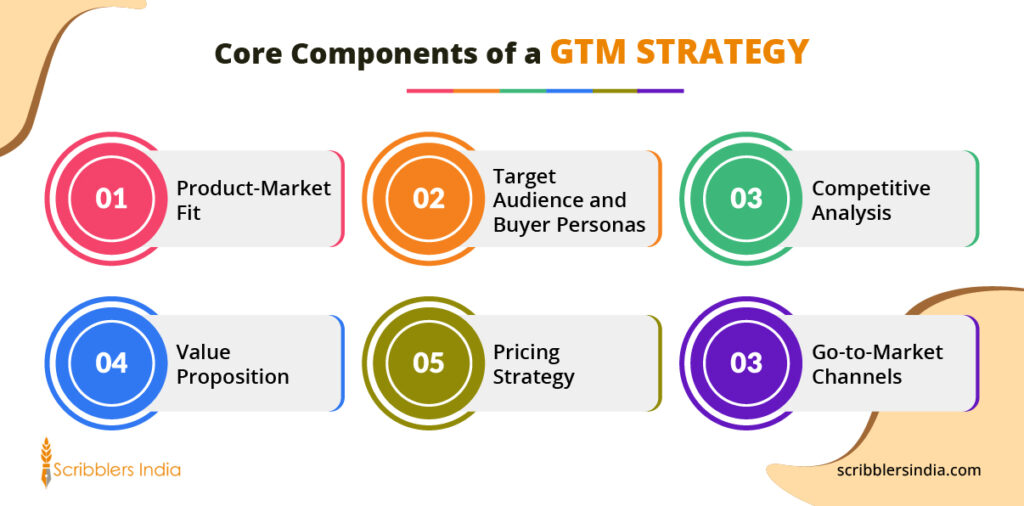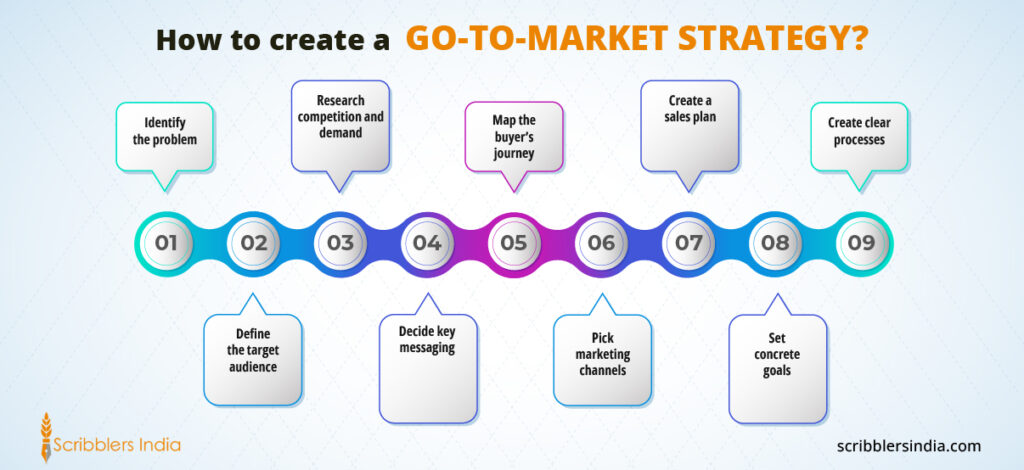Launching a new product or service without a solid plan is like setting sail without a compass. Your go-to-market strategy serves as that compass, guiding your product from conception to successful market adoption.
According to Harvard Business School research, over 30,000 new products enter the market annually, yet approximately 95% fail. The difference between success and failure often comes down to having a well-structured go-to-market plan that connects your product with the right audience at the right time through the right channels.
This article explores the different aspects of a comprehensive go to market strategy including its meaning, core features, benefits and more.
What is a Go-to-Market Strategy?
A go-to-market strategy is a comprehensive action plan that outlines how a company will reach target customers and achieve competitive advantage when introducing a new product or service to the market. It’s the roadmap that defines your positioning, messaging, and channels to deliver your product effectively.
Unlike a marketing strategy which focuses on ongoing promotion, your GTM strategy specifically addresses the launch phase of your product or service. It answers crucial questions: Who are your ideal customers? What problem does your product solve? How will you reach your audience? What’s your unique value proposition?
This strategic blueprint integrates marketing, sales, and distribution to ensure your product doesn’t just launch—it lands successfully in the hands of customers who need it most.
What is the Importance of a Go To Market Strategy?
Why is a go-to-market strategy crucial for your business? A well-crafted GTM strategy reduces launch risk, ensures efficient resource allocation, accelerates time-to-market, and creates alignment between sales, marketing, and product teams. Without it, even exceptional products risk failure in the marketplace.
In today’s competitive landscape, businesses can’t afford to launch products without strategic direction. A comprehensive GTM strategy provides several key benefits:
- Risk reduction: With 95% of new products failing, a solid GTM strategy helps validate market fit before full-scale investment.
- Resource optimization: By identifying the most effective channels and approaches, you avoid wasting budget on ineffective tactics.
- Competitive differentiation: Your strategy helps position your offering distinctly in the marketplace, highlighting your unique value.
- Faster revenue generation: A clear path to market accelerates customer acquisition and shortens time to ROI.
- Cross-functional alignment: A GTM strategy ensures all teams work cohesively toward the same goals with clear roles and responsibilities.
The stakes are particularly high in 2025, as market dynamics continue to evolve rapidly with technological advancements and changing customer expectations.
What are the core components of a GTM Strategy?
The core components of an effective go-to-market strategy include product-market fit, target audience definition, competitive positioning, value proposition, pricing strategy, distribution channels, sales methodology, and measurement frameworks. Each element works together to create a cohesive plan for successful market entry.
Let’s examine each component in detail:
Product-Market Fit
This foundational element confirms your product solves a genuine market problem. Without product-market fit, even the best execution will fail. Validate through market research, beta testing, and customer feedback before full launch.
Target Audience and Buyer Personas
Detailed profiles of your ideal customers help tailor your messaging and channel strategy. These should include demographic information, pain points, purchasing behaviors, and decision-making factors.
Competitive Analysis
Understanding your competition reveals market gaps and opportunities for differentiation. This analysis should evaluate competitor strengths, weaknesses, pricing, and positioning.
Value Proposition
Your unique value proposition articulates why customers should choose your product over alternatives. It should clearly communicate benefits and competitive advantages in customer-centric language.
Pricing Strategy
Your pricing model must align with your value proposition, target market expectations, and business objectives. Whether subscription-based, consumption-based, or tiered, pricing significantly impacts market perception.
Go-to-Market Channels
These are the pathways to reach your customers, including direct sales, partner networks, digital marketing, and self-service options. Channel selection should align with customer preferences and purchasing behavior.
Integrating these components creates a comprehensive framework for successful market entry and sustainable growth.

When Do You Need a Go-to-Market Strategy?
You need a go-to-market strategy when launching new products, entering new markets, repositioning existing offerings, or implementing significant business model changes. Any scenario where you’re connecting an offering with a specific market segment requires strategic planning to ensure success.
Here are the key scenarios when a GTM strategy becomes essential:
- New product launch: Whether you’re a startup introducing your first offering or an established company expanding your product line, a GTM strategy minimizes launch risks.
- Market expansion: Entering new geographic regions or vertical industries requires tailored approaches to address unique market characteristics and customer needs.
- Business model transformation: Shifting from traditional sales to subscription models or implementing consumption-based pricing demands a strategic transition plan.
- Repositioning: When market conditions change or competition intensifies, repositioning your product requires a fresh GTM approach to communicate new value propositions.
- Mergers and acquisitions: Integrating acquired products into your portfolio necessitates clear GTM strategies to maintain momentum and capitalize on new opportunities.
The more complex your offering or market, the more critical a well-structured GTM strategy becomes to navigating potential obstacles and ensuring successful outcomes.
Which Are Some Successful Go to Market Strategy Examples?
Successful go-to-market strategies come in various forms, each tailored to specific business models and market conditions. The following real-life examples demonstrate how diverse approaches can lead to market success when executed effectively.
1. Slack: Product-Led Growth
Slack revolutionized workplace communication through a product-led growth strategy. They created a freemium model where teams could use the basic version indefinitely, with premium features unlocked through paid subscriptions. This approach allowed organic growth within organizations, as usage naturally expanded from team to team, creating bottom-up demand that eventually reached decision-makers.
2. Oatly: Channel Partnership Strategy
Oatly transformed from a niche alternative milk to a mainstream sensation through strategic coffee shop partnerships. Rather than competing for retail shelf space initially, Oatly targeted specialty coffee shops where baristas became product advocates. This created consumer demand before Oatly expanded to retail channels, demonstrating the power of strategic channel selection.
3. Native: User-Generated Content Approach
Natural deodorant brand Native scaled rapidly by leveraging user-generated content from micro-influencers. This authentic marketing approach built credibility while keeping acquisition costs low. By prioritizing genuine customer testimonials over traditional advertising, Native created trust in a category where consumers were particularly skeptical about natural alternatives.
4. GumGum: Account-Based Marketing Excellence
AI company GumGum created a personalized comic book featuring T-Mobile’s CEO as a superhero to break through to this high-value prospect. This ultra-targeted ABM approach resulted in securing T-Mobile as a client and demonstrates how creative, personalized outreach can be effective for complex B2B sales.
5. Salesforce: Enterprise Sales Model
Salesforce pioneered the SaaS model with an enterprise-focused GTM strategy combining consultative selling with industry-specific solutions. Their approach involves a sophisticated sales organization targeting decision-makers in large organizations, supported by thought leadership content and industry events that position them as business transformation partners rather than just software vendors.
These examples highlight how successful GTM strategies align with business models, target audiences, and unique value propositions—proving there’s no one-size-fits-all approach to market entry.
How to create a go-to-market strategy?
Building an effective go-to-market strategy requires a systematic approach that begins with problem identification and ends with establishing clear processes for execution and optimization. This step-by-step framework ensures all critical elements are addressed before launch.
Step 1: Identify the problem
The foundation of any successful go-to-market strategy is clearly identifying the specific problem your product or service solves. This problem must be significant enough that customers are willing to pay for a solution.
- Begin by conducting comprehensive market research to validate the problem exists and affects a substantial number of potential customers.
- Gather both quantitative data through surveys and qualitative insights through customer interviews.
- Document specific pain points, workarounds customers currently use, and the impact of these problems on their business or life.
The problem statement should be specific, measurable, and tied to customer outcomes rather than your product features. This clarity ensures your entire GTM strategy addresses genuine market needs rather than assumed ones.
Step 2: Define the target audience
Your target audience definition should go beyond basic demographics to create detailed buyer personas that capture motivations, challenges, and decision-making processes. These personas will guide your messaging, channel selection, and sales approach.
For B2B products, identify not just the company profile (industry, size, revenue) but also the buying committee roles—from end-users to ultimate decision-makers. For B2C offerings, understand lifestyle factors, purchasing behaviors, and emotional drivers.
Effective targeting often means narrowing your focus initially rather than trying to appeal to everyone. This concentrated approach allows more efficient resource allocation and clearer messaging that resonates deeply with specific segments.
Step 3: Research competition and demand
Competitive analysis reveals market gaps and positioning opportunities, while demand research confirms sufficient market potential exists. This dual research approach prevents launching into oversaturated or underdeveloped markets.
- Map direct competitors (offering similar solutions) and indirect competitors (solving the same problem differently).
- Analyze their strengths, weaknesses, pricing models, and go-to-market approaches.
- Look for underserved segments or unaddressed pain points that create your opportunity.
Estimate market size and growth trajectory using both top-down (total addressable market) and bottom-up (building from specific customer segments) approaches. This validation ensures your target market can support your growth objectives.
Step 4: Decide key messaging
Your messaging should articulate a clear value proposition that connects your solution to customer problems in compelling, benefit-focused language. Effective messaging cuts through market noise and makes your offering instantly understandable.
Develop a messaging hierarchy that includes:
- Core value proposition (primary benefit)
- Supporting messages (how you deliver the benefit)
- Evidence points (proof your solution works)
- Emotional appeals (why customers should care)
Test messaging with target audience members to ensure it resonates and clearly communicates your differentiation. Refine based on feedback before finalizing your messaging framework.
Step 5: Map the buyer’s journey
Mapping the buyer’s journey helps you understand how customers move from problem awareness to purchase decision, allowing you to create targeted content and touchpoints for each stage. This alignment ensures you’re providing the right information at the right time.
A typical buyer’s journey includes:
- Awareness stage: Customer recognizes they have a problem
- Consideration stage: Customer evaluates potential solutions
- Decision stage: Customer selects a specific solution
- Implementation stage: Customer deploys the solution
- Expansion stage: Customer seeks additional value
For each stage, identify customer questions, concerns, and information needs. Then develop stage-appropriate content and interactions that address these specific needs, gradually moving prospects toward purchase.

Step 6: Pick marketing channels
Selecting the right marketing channels ensures your message reaches your target audience efficiently and effectively. Channel selection should be based on audience behavior rather than trending platforms.
Consider both inbound channels (content marketing, SEO, social media) and outbound approaches (direct sales, events, advertising). Prioritize channels based on:
- Where your target audience seeks information
- Cost of customer acquisition through each channel
- Scalability of the channel as you grow
- Alignment with your sales model and purchase complexity
The most effective GTM strategies typically use an integrated multi-channel approach, with primary and supporting channels working together to create multiple touchpoints throughout the buyer’s journey.
Step 7: Create a sales plan
Your sales plan defines how prospects convert to customers, including sales methodologies, team structure, and enablement resources. This plan should align perfectly with your marketing channels and buyer’s journey.
Determine whether you will use inside sales, field sales, partner channels, or self-service approaches based on your product complexity and price point. Define qualification criteria, sales process stages, and typical conversion timeframes.
Develop sales enablement materials including pitch decks, demo scripts, competitive battlecards, and objection handling guides. Ensure consistent messaging between marketing materials and sales conversations to create a seamless customer experience.
Step 8: Set concrete goals
Establishing specific, measurable goals for your go-to-market strategy creates accountability and provides clear benchmarks for success evaluation. These goals should connect directly to business outcomes.
Develop both leading indicators (early signs of traction) and lagging indicators (ultimate business results). Key metrics might include:
- Customer acquisition cost (CAC)
- Conversion rates at each funnel stage
- Time to first sale/revenue
- Customer lifetime value (LTV)
- Market share within target segments
Set realistic timeframes for achieving these goals, recognizing that complex products or new categories may require longer runways to show meaningful results.
Step 9: Create clear processes
Documented processes ensure consistent execution and enable continuous optimization of your go-to-market strategy. These processes should cover cross-functional workflows and decision criteria.
Establish processes for:
- Lead qualification and routing
- Sales and marketing collaboration
- Customer onboarding and success
- Feedback collection and product iteration
- Performance reporting and analysis
Include clear ownership for each process component and regular review cycles to identify improvement opportunities. Document these processes for team alignment and to facilitate onboarding as you scale.
Go-to-Market Strategy Template
A go-to-market strategy template provides a structured framework to organize your planning and ensure all critical elements are addressed. Our free template helps you document your strategy in a comprehensive, actionable format.
Our template includes the following sections, each with guided questions and examples to facilitate your planning process:
- Executive Summary
- Brief overview of the product/service
- Target market and key differentiators
- High-level timeline and success metrics
- Market Analysis
- Target market size and growth rate
- Customer segments and personas
- Competitive landscape assessment
- Market trends and timing considerations
- Product Positioning
- Value proposition and key benefits
- Feature prioritization aligned with customer needs
- Pricing strategy and packaging options
- Competitive differentiation points
- Go-to-Market Channels
- Primary and secondary channel selection
- Channel-specific messaging adjustments
- Partner/reseller strategy (if applicable)
- Channel economics and investment requirements
- Marketing Plan
- Content strategy by buyer journey stage
- Campaign timeline and key activities
- Budget allocation across channels
- Lead generation targets and processes
- Sales Strategy
- Sales methodology and process
- Team structure and territory planning
- Enablement requirements and training plan
- Incentive structure and commission model
- Success Metrics
- KPI definition and tracking methods
- Revenue and adoption targets
- Timeline for achieving key milestones
- Process for reviewing and adjusting strategy
At Scribblers India, we are offering this comprehensive template as a downloadable resource to help businesses streamline their go-to-market planning. Our template is designed to be customizable for different business models and product types while ensuring no critical elements are overlooked.
How to Choose the Best Go-to-market Strategy for Your Business?
Choosing the optimal go-to-market strategy requires evaluating your specific business context, including product complexity, target audience characteristics, competitive landscape, and internal capabilities. The best strategy aligns these factors with your business objectives and resources.
Consider these key factors when selecting your GTM approach:
- Product complexity and price point: Higher-complexity or higher-priced offerings typically require more consultative, sales-led approaches, while simpler products may succeed with product-led or marketing-led strategies.
- Customer acquisition economics: Compare potential customer lifetime value against acquisition costs through different channels to determine sustainable approaches. Some strategies may yield faster results but at higher costs.
- Competitive differentiation opportunities: If competitors dominate certain channels, you might need to pioneer alternative approaches. Your differentiation may dictate channel selection and positioning strategy.
- Internal capabilities and resources: Assess your team’s strengths and experience. A sales-led approach requires strong sales talent, while content marketing demands consistent content creation capabilities.
- Market maturity: New categories often require more educational marketing, while established markets may benefit from clear differentiation and competitive displacement strategies.
The most successful companies often begin with a focused GTM strategy targeting a specific segment, then expand to additional approaches as they grow. This allows for resource concentration and clearer messaging initially, followed by broader market penetration over time.
Why Choose Scribblers India for Your GTM Strategy?
At Scribblers India, we combine strategic expertise, data-driven insights, and creative execution to develop go-to-market strategies that deliver measurable results. Our approach integrates market intelligence with practical implementation planning to create realistic, actionable GTM frameworks.
We understand that effective go-to-market planning requires both analytical rigor and creative thinking. Our comprehensive approach includes:
- Market opportunity assessment: We conduct thorough market research to validate opportunities and identify the most promising customer segments for your offering. Our data-driven approach ensures your strategy targets genuine market needs.
- Competitor intelligence: Our team analyzes competitor strategies to identify positioning opportunities and potential threats. This intelligence informs differentiation approaches and helps anticipate competitive responses.
- Channel optimization: We assess channel effectiveness for your specific offering and audience, creating integrated multi-channel approaches that maximize reach while controlling acquisition costs.
- Messaging development: Our messaging frameworks translate technical capabilities into customer benefits, creating compelling value propositions that resonate with target audiences.
- Implementation planning: We don’t just develop strategies—we create detailed execution roadmaps with realistic timelines, resource requirements, and success metrics to guide implementation.
Our clients consistently achieve faster market traction and higher conversion rates through our structured yet flexible GTM methodologies. We become an extension of your team, bringing specialized expertise while ensuring alignment with your broader business objectives. Ready to transform your go to market approach? Schedule a free 30-minute GTM strategy consultation with our expert team today.
Final Thoughts
Creating an effective go-to-market strategy is about building a foundation for sustainable growth. The nine-step process outlined in this guide provides a comprehensive framework to develop a strategy that connects your product with the right customers through the most effective channels.
Remember that even the best strategies require continuous refinement based on market feedback and performance data. The most successful companies view their GTM strategy as a living document that evolves as they gain market insights and as competitive landscapes shift.
Whether you are launching a completely new offering or expanding into new markets with existing products, a well-structured go-to-market plan dramatically increases your chances of success. By investing time in thorough planning before launch, you avoid costly mistakes and position your product for maximum market impact.
Frequently Asked Questions
What is the difference between a marketing strategy and a go-to-market strategy?
A go-to-market strategy focuses specifically on the plan to introduce a new product or service to market, while a marketing strategy addresses ongoing promotion of established offerings. The GTM strategy is time-bound around a launch, while marketing strategy continues throughout a product’s lifecycle.
How long does it take to develop an effective go-to-market strategy?
Developing a comprehensive go-to-market strategy typically takes 4-8 weeks, depending on product complexity, market research requirements, and organizational alignment needs. Rushing this process often leads to missed opportunities or misaligned messaging.
Should startups and enterprises use different go-to-market approaches?
Yes, startups and enterprises often require different GTM approaches based on their resources, market position, and risk tolerance. Startups typically need more focused strategies targeting specific niches, while enterprises can leverage existing channels and customer relationships for broader launches.
How do you measure the success of a go-to-market strategy?
Success metrics for a go-to-market strategy should include customer acquisition cost, time-to-revenue, conversion rates through the funnel, and ultimate market penetration within target segments. Both leading indicators (early engagement) and lagging indicators (revenue outcomes) should be tracked.
How often should we update our go-to-market strategy?
Your go-to-market strategy should be reviewed quarterly and updated whenever significant market changes occur, competitor actions shift the landscape, or customer feedback indicates necessary pivots. The core strategy may remain stable while tactical elements are adjusted more frequently.






